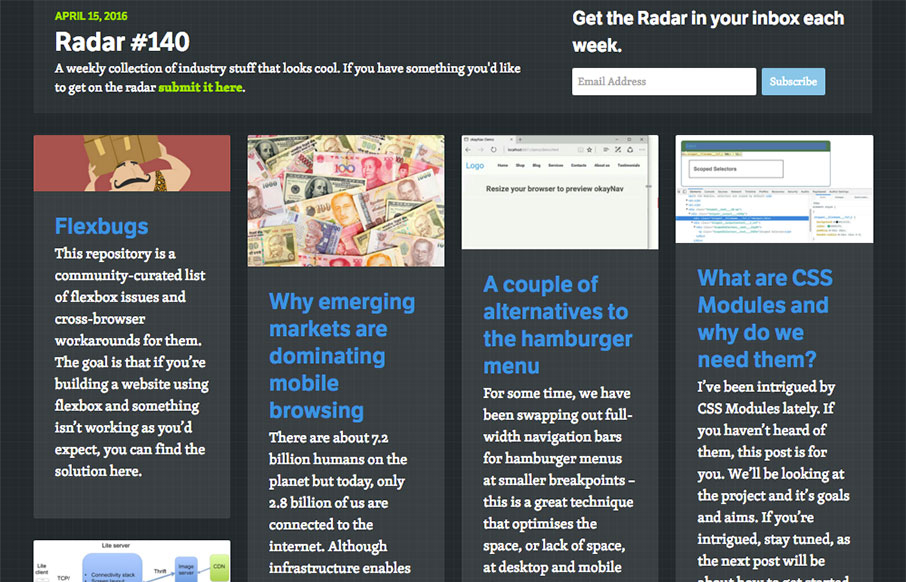Each week, we do a round up of curated “stuff from the interwebs” that we call Radar.
Flexbugs
This repository is a community-curated list of flexbox issues and cross-browser workarounds for them. The goal is that if you’re building a website using flexbox and something isn’t working as you’d expect, you can find the solution here.
Why emerging markets are dominating mobile browsing
There are about 7.2 billion humans on the planet but today, only 2.8 billion of us are connected to the internet. Although infrastructure enables internet access to over 85 percent of the planet, most people living in emerging markets are just starting to connect.
A couple of alternatives to the hamburger menu
For some time, we have been swapping out full-width navigation bars for hamburger menus at smaller breakpoints – this is a great technique that optimises the space, or lack of space, at desktop and mobile sizes. But what about the masses of unused screen real-estate once the full-width navigation has turned into a hamburger?
What are CSS Modules and why do we need them?
I’ve been intrigued by CSS Modules lately. If you haven’t heard of them, this post is for you. We’ll be looking at the project and it’s goals and aims. If you’re intrigued, stay tuned, as the next post will be about how to get started using the idea.
How we built Facebook Lite for every Android phone and network
We rolled out Facebook Lite, our version of Facebook for Android built for emerging markets, in June of 2015. Today we’re excited to share that the app has hit 100 million monthly active users. With Facebook Lite, our goal is to provide the best possible Facebook experience to everyone, no matter their device or connection. […]
Pareto Principle-Based User Research
By applying the Pareto Principle to user research, you can identify the top percentage of your product’s usability issues and feature gaps, then jump in and fix them.
9 trends that will change the design landscape
With new brand touchpoints, technologies and user behaviour, it’s never been more important to engage your audience. Here’s how…
Preload Hints For Web Fonts
Web fonts are a popular topic in the web performance community. However, one fundamental problem is often overlooked: web fonts are lazy loaded. Can web font preload hints help us?
Watch: Creating High Resolution Background Images with CSS
In this screencast Russ Weakley shows you how to create high resolution background images including at a 2x and 3x resolution for narrow and wide screens using the
Next level layout
by Chris Wright – A talk about how we can embrace new features to help us simplify our design systems – combining different layout techniques so that we don’t have to tie our components to our viewports and use media queries to size them, using progressive enhancement to help us experiment with the newest features […]
If you want to add something to next week’s Radar – submit it here.
Here’s the link to this week’s batch of goodness: Radar #140.





0 Comments